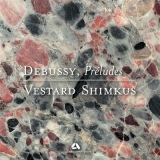Der lettische Pianist Vestard Shimkus spielt die Sammlung der 24 Préludes von Claude Debussy mit wachem Geist und genau überlegtem Ansatz. Nicht so sehr die Farben sind es, die ihn interessieren, sondern die Relativität des Rhythmus, aus der sich die Stimmungen ableiten, die Shimkus in dieser Interpretation für sehr persönliche Akzente benutzt. Mitunter wird die Musik dadurch auch sehr dramatisch und klingt dabei sehr spannend neuartig.
Ein gutes Beispiel für dieses rhythmische Gespür und die innovative Metrik der Interpretation sind wohl Ce qu’a vu le vent d’Ouest und La sérénade interrompue, die, wie so manche Stücke in dem Zyklus, einen fast improvisatorischen Charakter bekommt.
In La cathédrale engloutie gelingt Shimkus eine ideale Mischung aus geheimnisvoller Atmosphäre und Grandeur. Mit Minstrels beschließt er sehr eigenwillig das erste Buch. Die Rhythmik dieses Stücks haben diverse Pianisten versucht, neu zu gestalten, aber im Vergleich zeigt sich, dass es keinem, nicht einmal Friedrich Gulda gelungen ist, zu einem derart überzeugenden Resultat zu gelangen.
Shimkus gelingen in Buch II ebenso wirkungsvolle Interpretationen. Sein genuines Gespür für diese Musik erweckt die Brouillards, ein Stück, das trocken und sogar streng daherkommen kann, zu neuem Leben: Debussys Nebel sind geheimnisvoll und enthalten eine direkt bedrohlichen Energie, die durch sie pulsiert.
Sehr subtil, mit feinsten Klangschattierungen vermittelt der Pianist den Charakter der Habanera La puerta del Vino und das Tänzerische der Feen. Exzellent ist auch Ondine mit seinem teils verspielten, teils schelmischen Charakter.
Die prickelnde Erregung der sprühenden Funkenfontänen von Feux d’artifice wird ergänzt durch einen Hauch von Magie.
Mithin reiht sich diese Aufnahme auf bestem Platz unter die vielen guten Einspielungen der Debussys-Préludes ein und sorgt für neue und frische Ideen.
Latvian pianist Vestard Shimkus plays Claude Debussy’s collection of 24 Préludes with an alert mind and a carefully considered approach. It is not so much the colors that interest him, but the relativity of the rhythm from which the moods derive, which Shimkus uses in this interpretation for very personal accents. At times this makes the music very dramatic, sounding very excitingly novel.
A good example of this rhythmic sense and the innovative metrics of the interpretation are probably Ce qu’a vu le vent d’Ouest and La sérénade interrompue, which, like so many pieces in the cycle, takes on an almost improvisatory character.
In La cathédrale engloutie, Shimkus achieves an ideal blend of mysterious atmosphere and grandeur. With Minstrels he closes the first book in a very idiosyncratic way. Various pianists have tried to recreate the rhythms of this piece, but comparison shows that none, not even Friedrich Gulda, has succeeded in achieving such a convincing result.
Shimkus succeeds in equally effective interpretations in Book II. His genuine feel for this music brings to life the Brouillards, a piece that can come across as dry and even austere: Debussy’s mists are mysterious and contain a directly menacing energy that pulses through them.
Very subtly, with the finest shadings of sound, the pianist conveys the character of the Habanera La puerta del Vino and the dance-like quality of the Fairies. Ondine is also excellent, with its part playful, part mischievous character.
The tingling excitement of the sparking fountains of Feux d’artifice is complemented by a touch of magic.
Thus this recording ranks well among the many good recordings of Debussy’s Préludes and provides new and fresh ideas.






















